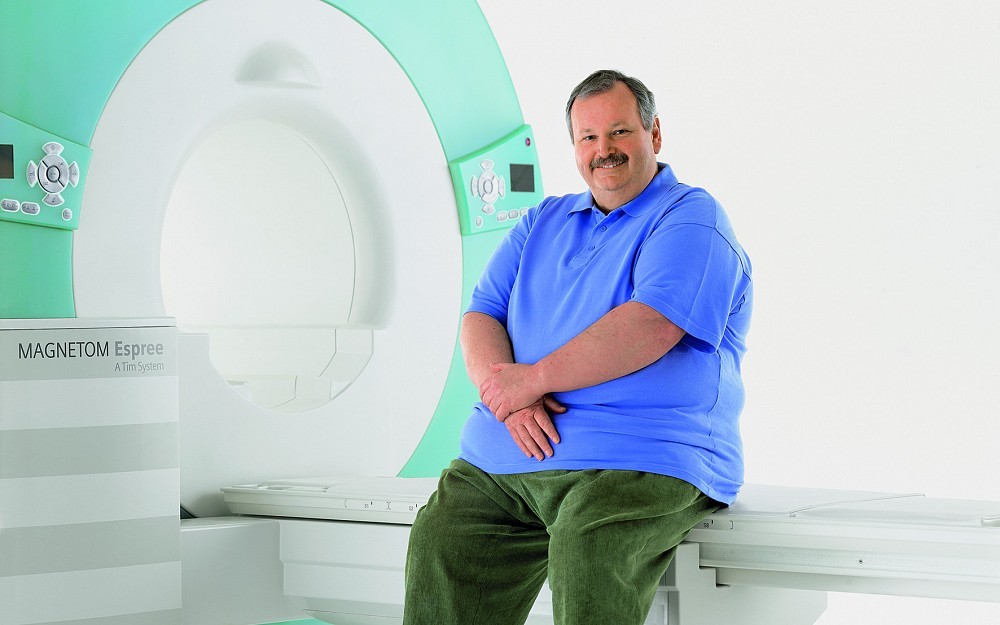
New Imaging Center Delivers Better Care to Athletes and Large Patients
CINCINNATIPhysicians at the University of Cincinnati (UC) are opening a state-of-the-art magnetic resonance imaging (MRI) center that gives virtually any patientincluding bulky athletes and the obesecomfortable access to quality body imaging.
Located in the Richard E. Lindner Athletic Center on UCs West Campus, the 2,110-square-foot Varsity Village Imaging Center will feature the Siemens Espree. This 1.5 tesla (T) high-field-strength MRI machine has a shorter scanning field (about four feet) and a larger opening (two-foot diameter) than other high-field-strength systems.
Were able to comfortably accommodate large athletes and obese and claustrophobic patients, explains Robert Wissman, MD, director of the Varsity Village Imaging Center and UC assistant professor of radiology. The Espree is a traditional high-field scanner with the comfort of an open system.
MRI is an imaging procedure that uses a magnetic field and radio-wave energy pulses to create pictures of organs and body structures. The test is used to detect, diagnose and plan treatment for a variety of disorders.
Most traditional high-field MRI scanners have a 350-pound weight limit. Patients who are too heavy or large to fit into a traditional scannerlike football defensive linemenare often examined on an open MRI system, which is typically lower in field strength. This system can accommodate patients who weigh up to 550 pounds.
In a city where some patients have to wait two weeks for an MRI scan, Dr. Wissman says, the Varsity Village Imaging Center is set up to quickly accommodate walk-in patients, like athletes, who need timely answers about their injuries.
The Varsity Village Imaging Center is uniquely situatedboth in physical location and professional trainingto offer top quality musculoskeletal imaging to athletes, adds Robert Lukin, MD, chair of the department. Patient care is our No. 1 priority and with this technology we can give nearly all our patients access to high-field imaging careregardless of size.
Unlike traditional MRI scannerswhich require patients to enter a narrow scanning tunnel and to hold their breaththe Esprees short magnet allows about 60 percent of scans to be done with the patients head outside the magnet.
Many patients experience anxiety in traditional scanners because they feel like theyre nose-to-nose with the magnet, explains Dr. Lukin. Although the Espree is a closed system, it feels very open, and most patients have a full foot of headroom.
The Varsity Village Imaging Center scanner will be the only large-opening high-field MRI system within about an hours drive of Cincinnati. Physicians expect to see about 15 patients a day.
A collaborative effort of UCs pathology, neurology, orthopaedics, radiology and rehabilitation practice groups, the Varsity Village Imaging Center will begin seeing patients on March 23.
Tags
Related Stories
UC study: Brain organ plays key role in adult neurogenesis
July 2, 2024
The University of Cincinnati has published research in the Proceedings of the National Academy of Sciences that found the choroid plexus and cerebrospinal fluid play a key role in maintaining a pool of newly born neurons to repair the adult brain after injury.
Put down that beer; it's not a tanning lotion
July 1, 2024
The University of Cincinnati's Kelly Dobos joined WVXU's Cincinnati Edition to discuss what's fact and what's myth when it comes to sunscreen use, different kinds of sunscreen and a social media recommendation to use beer on your skin to help get a tan.
Cincinnati researchers want to know if MRIs can work better
June 28, 2024
WVXU and the Cincinnati Business Courier highlighted a new collaboration between the University of Cincinnati College of Medicine, UC Health GE HealthCare, JobsOhio, REDI Cincinnati and Cincinnati Children’s to create an MRI Research and Development Center of Excellence located on UC’s medical campus.
